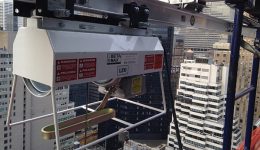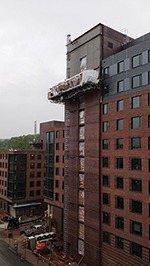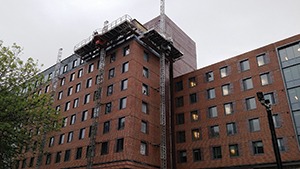Mast Climbers
By Troy Palmer

Every project that involves doing work at height involves some of the same logistical challenges: how to get your workers in position, how to get tools and material into position, how to keep overhead costs under control, etc. In order to increase profits and be able to bid jobs competitively, focusing on productivity is one of the keys to success.
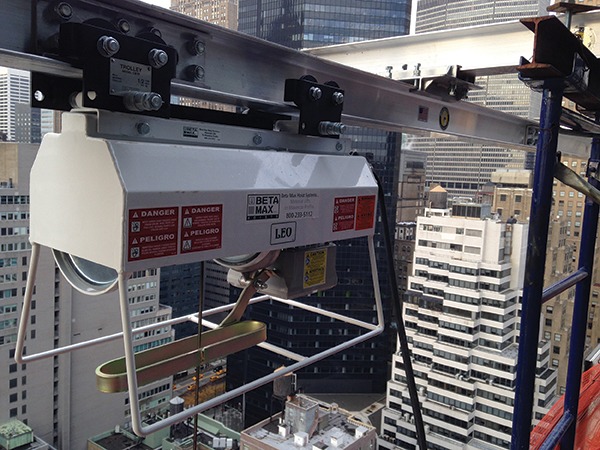
The number-one rule to getting more done when working at height is to keep your producers (skilled labor) in place and producing until the job is done.
This sounds obvious, but construction crews break this rule all the time, and it adds up to wasted time and money. Three common mistakes frequently occur on jobsites:
Mistake #1: Using your swing stage or mast-climbing work platform as a material delivery system.
Mast climbers and swing stages are amazing for getting your skilled workers in position in hard-to-reach areas. But once you have moved those people into position, DO NOT move them out of that spot to get more tools or materials! This may sound trivial, but on a 100-foot building, just one round trip of a work platform to get materials can easily take up to 9 minutes. That is 9 minutes in which your skilled producers aren’t producing for just one trip that the platform or stage is moving up and down.
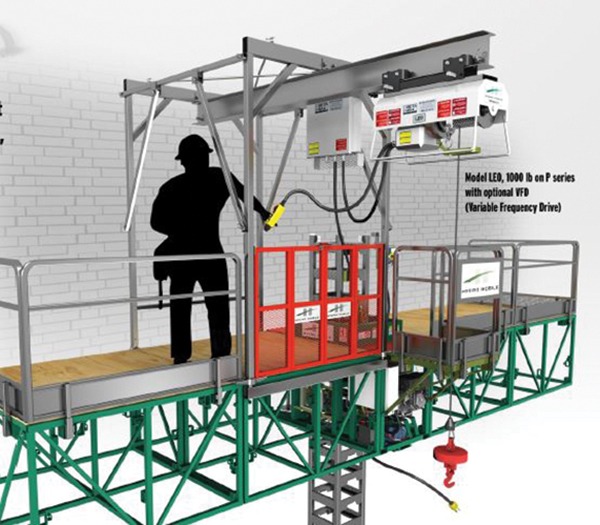
(Courtesy of Hydro Mobile)
If you do that just three or four times a day, you have lost 10 percent of your total day’s production.
Think about that. If you lose 10 percent of your production over a year’s worth of projects, you will pay out an additional month of wages with nothing to show for it. That is a month of your workers riding up and down instead of doing the job they are trained for.
Solution: Review jobs at height to see if your access equipment is doubling as your material delivery system. If it is, you should look for alternative methods to get your skilled workers the materials they need while they are in position.
Once you have figured out how to keep your skilled workers in position, the other part of the #1 Rule is to keep them producing. This is where the other common mistakes come in. If your producers are standing around waiting on materials, they are not producing and you are losing money.
Mistake #2: Using a material delivery plan without having 100 percent control.
Sharing crane and forklift time with other crews may sound like a good idea to keep costs down, but when one group hogs the equipment you need for material delivery, or it just isn’t available when you need it, the savings you were hoping for disappear quickly. When you share equipment, you are risking production delays, which translates into lost profits. You also risk your company’s reputation for getting work done on time. Delays wreck profits and reputations.
Solution: Find a material delivery system over which you have 100 percent control.
Mistake #3: Not delivering materials to your key skilled people fast enough.
Because the goal is to keep your producers producing, it is important to avoid having them waiting around for materials. Many methods of delivering material at height are too slow or inconsistent. Ropes and pulleys are slow, and limit the amount of material that can be delivered at one time. Daisy chains (man-lines passing material up and down scaffolding) can work well in theory, but delays are frequent, material delivery is compromised, and most importantly, this practice is prone to the risk of injury from material being dropped or mishandled. Many companies have done away with daisy chains due to accidents and injuries.
Solution: Use a safe, fast and consistent material delivery system that gets materials to your workers as fast as they need them.
One of the best ways to deliver materials to workers on work platforms, swing stages or elevating scaffolding systems is to use a high-speed, portable material hoist. In many cases, these hoists can be designed as an add-on or to work in conjunction with mast climbers or other work platforms. Mast climbers and work platforms utilizing Beta Max’s Leo line of hoist products as an accessory allow additional material to be lifted to the platform at 80 feet per minute (fpm) without having to take the platform back to the ground level.
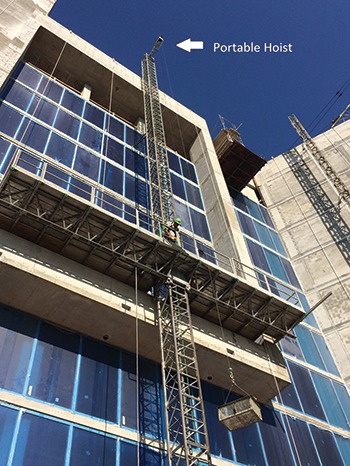
(Courtesy of Sunbelt Rentals)
Non-Stop Scaffolding, Hydro Mobile and Sunbelt Rentals have all teamed with Beta Max in order to offer efficient and economical complete hoisting solutions to their customers. (Hydro Mobile platforms with the Leo hoist can be seen live at the SPEC MIX BRICKLAYER 500® World Championship each year at the World of Concrete in Las Vegas.)
Justin Breithaupt Jr., owner of Non-Stop Scaffolding Inc., told us, “Our customers have been asking for a material hoist for a long time. When we set out to design a solution, we looked for an existing hoist from a reputable manufacturer — we didn’t want to re-invent the wheel. It had to be lightweight, have plenty of lifting power, and be easy to install and take down. The Beta Max Leo fit all our requirements. Our customers have found them to be durable and that they last a long time. We recommend the soft start and stop version of the hoist. It costs a little more, but it doesn’t shake the scaffold like a regular hoist can, and doesn’t alarm the workers. It’s also much more tolerant of low voltage and long cord runs.”
At less than 200 lbs., the Leo hoist is easy to install on masonry scaffolding. For instance, Non-Stop employs a taller version of their overhead protection/winter enclosure bracket to position the hoist over the laborers’ platform. It is very easy to set up and adds less than 500 lbs. (including the hoist) to a tower. Even when hoisting 2,000 lbs. of materials, the user is well under Non-Stop’s maximum capacity of 4,000 lbs. per tower.
Tyler Watts of True-Bond Masonry in Shreveport, La., said, “We were really impressed with how quick and easy the Beta Max hoist system went on our Heavy Duty system. Having never installed it before, we thought it was going to be a lot more challenging. Our scaffold was 30 feet in the air when we installed it, and we had no trouble getting it set up. Having the hoist system meant we didn’t have to rent a crane to get heavy pre-cast material up to the masons. It was perfect for areas where our forklift couldn’t reach. I hate to think about what crane rental would have cost, but it would have been a lot more than what we paid for the hoist system.”
Sunbelt Rentals now also offers Beta Max portable material hoists on their mast-climbing systems. Here is what regional manager Brad Kruger had to say:
“When utilizing mast-climbing work platforms, we always recommend the use of portable hoists as the most effective method of hoisting materials to workers at elevated heights. Portable hoists offer the safest, most efficient means of getting materials to the work area, while saving the contractors time and money. As a regional manager for Sunbelt Rental’s scaffold locations in Florida, I encounter scenarios all the time in which Beta Max portable hoists are the perfect solution for our customers’ material handling needs. Whether it is a Scorpio Hoist for hoisting stucco to a scaffold or the higher-capacity Leo XXL VFD for high-rise glazing, Beta Max always has the right hoist for whatever the customer’s hoisting requirement may be. This allows us to offer a complete access package.”
With lifting capacities of up to 2,000 lbs. and lifting speeds of up to 80 fpm, portable hoists are a great material delivery solution for workers on any mast-climbing work platform, suspended or elevating scaffolding. Beta Max Inc., based in Palm Bay, Fla., has been providing high-speed material hoists to the masonry industry for over 30 years. For more information about the full line of Beta Max hoists, visit www.betamaxhoist.com.
Troy Palmer is director of sales and marketing for Beta Max Inc. He can be reached at tpalmer@betamaxhoist.com.
In The NewsFRACO: Quebec Manufacturer Involved in a Large Housing Development in Maryland |
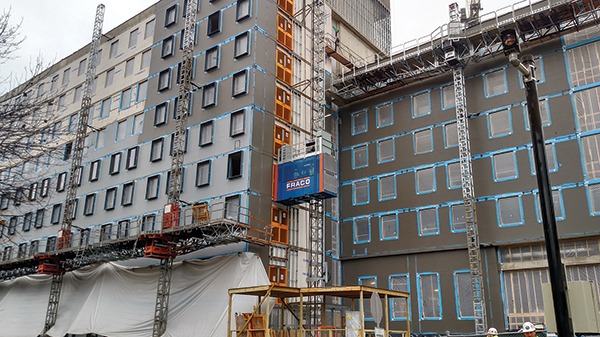
In 2014, Towson University in Maryland began the construction of phases 3 and 4 of West Village Housing, a residential project adding 700 beds to the university campus that already has more than 2,100. For this project, two 9- and 11-story buildings have been built simultaneously in order to meet the growing demand for residences on campus. The additional housing is scheduled to be available in summer 2016. In order to meet a tight schedule, the general contractor, Whiting Turner Contracting Co. (Baltimore, Md.), and masonry contractor, Banner Masonry (Gwynn Oak, Md.), asked Fraco Products to prepare an offer of work platforms capable of accommodating several trades with access to the building envelope. Fraco’s offer had to take into account constraints such as limited access to buildings and nearly incessant pedestrian and vehicle traffic near the site.
Considering the tight schedule and the difficult conditions of the job site, Fraco platforms were considered the best solution to allow the various trades to work cooperatively to complete the exterior envelope of these two buildings. For more information, contact: Daniel Hurley, sales representative, Fraco USA Inc., (443) 250-7221, dan.hurley@fraco.com, or Jacques Lainé, director of marketing, Fraco Products Ltd., (514) 713-1212, jacques.laine@fraco.com. |
